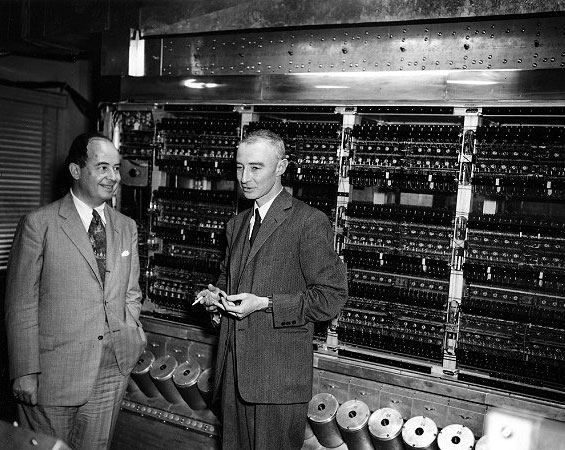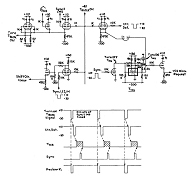Electronic Computer Project
In late 1945, the Institute for Advanced Study embarked on a project that departed from the realm of the purely theoretical. With no laboratory facilities, the Institute was not, at first sight, an obvious choice for Professor John von Neumann’s Electronic Computer Project. But these were extraordinary times–times of war and postwar urgency, and von Neumann was a persuasive advocate for the project. Over the objections of some IAS Faculty and with the support of others, such as Oswald Veblen and Institute Director (1939–47) Frank Aydelotte, the project found a home, albeit initially in the basement of Fuld Hall.

The original impetus for an electronic computing device stemmed from the pressing demands of war. The goal of the ECP was to build a machine that would be a general-purpose postwar tool for the disparate branches of scientific research.
From the start of World War II, von Neumann had been heavily occupied as a consultant to the military. He was a member of the Scientific Advisory Committee at the Ballistic Research Laboratories at the Aberdeen Proving Ground in Maryland, from 1940 on; a member of the Navy Bureau of Ordnance from 1941 to 1955; a consultant to the Los Alamos Scientific Laboratory from 1943 to 1955; and a member of the Armed Forces Special Weapons Project in Washington, D.C., from 1950 to 1955.
Through a chance encounter, von Neumann engaged with a team of engineers in the University of Pennsylvania's Moore School of Electrical Engineering. J. Presper Eckert and John W. Mauchly were constructing an Electronic Numerical Integrator and Computer (ENIAC) under the leadership of J. G. Brainerd. Herman H. Goldstine, a mathematician and Reserve Officer of the Ordnance Department who was the army liaison to the Moore School, recognized von Neumann–already famous for his contributions to mathematics, physics, and economics–on a railway platform in 1944. Goldstine approached, introduced himself and, after a brief conversation, invited von Neumann to Philadelphia.

Even as the ENIAC was being constructed, its successor was being designed. Begun in 1943, ENIAC had thousands of vacuum tubes, and hundreds of thousands of resistors, capacitors, and inductors. Running on almost 200 kilowatts of electricity and weighing over thirty tons, it has been described as being bigger than a dinosaur with no more memory than a gnat. It became operational in 1945 and was formally dedicated in 1946. Von Neumann contributed immensely to the discussions of its successor.
In the spring of 1945, von Neumann drafted a document that described the logical structure of a desired high-speed automatic digital computing system powerful enough to solve complex mathematical problems, such as non linear partial differential equations (of two or three independent variables), in abstract terms drawn from biology. The abstraction freed the concepts of the nascent computer from the constraints posed by the technology of the era and, ultimately, stimulated the growth of that technology. Von Neumann's logical schema served as the basis for subsequent stored-program computers. In identifying the organs required as those relating to arithmetic, memory, control, and input and output devices, subsequently known as von Neumann Architecture, he laid down the basic schema of the modern computer. Von Neumann was fascinated by the relationship of computers to the brain, in particular, the relationship between the language of mathematics and the communications of the central nervous system.
Differences over individual contributions and patents divided the group at the Moore School. In keeping with the spirit of academic enquiry, von Neumann was determined that advances be kept in the public domain. ECP progress reports were widely disseminated. As a consequence, the project had widespread influence. Copies of the IAS machine appeared nationally: AVIDAC at Argonne National Laboratory; ILLIAC at the University of Illinois; JOHNNIAC at RAND Corporation; MANIAC at Los Alamos Scientific Laboratory; ORACLE at Oak Ridge National Laboratory; ORDVAC at Aberdeen Proving Grounds; and internationally: BESK in Stockholm; BESM in Moscow; DASK in Denmark; PERM in Munich; SILLIAC in Sydney; and WEIZAC in Rehovoth, to mention a few. In some cases (Argonne's Version of the Institute's Digital Automatic Computer (AVIDAC) and MANIAC at Los Alamos), because they benefited from the pioneering work of the Institute's prototype, copies were completed before the IAS machine was finished.

As William Aspray, in John von Neumann and the Origins of Modern Computing, states: The engineering challenges, especially in the design and construction of an acceptable primary memory unit, were more difficult than originally anticipated. The computer took almost twice as long as expected, nearly six years to complete. However, the finished product was faster and generally more powerful than the other computers of its era, and this power was put to good use in scientific research.
Herman Goldstine, who would later become scientific director of IBM, and his wife Adele Goldstine joined the ECP at the Institute, where von Neumann gathered an extraordinary team of mathematicians, scientists, engineers and technicians, not least of whom was Julian H. Bigelow (1913–2003). Bigelow joined the ECP in May 1946 as Chief Engineer. Born in Nutley, NJ, he studied mathematics and electrical engineering at M.I.T. and became a permanent Member in the School of Mathematics in 1951 and a pioneer in the fields of computing and cybernetics.
At the Institute, Bigelow's job was to take the logical design as laid out in the abstract by von Neumann and coax it to life using the electronics available in 1946, said George Dyson (Director's Visitor 2002–03). It was von Neumann's intent (succeeding beyond anyone's wildest dreams) that the computer developed at the Institute would be replicated around the world. Bigelow helped ensure not only that the computer got built, but that its design (and the explosion of software that followed) was disseminated through detailed progress reports and constant personnel exchanges for which the facilities and academic traditions of the Institute were ideal.
In 1980, Bigelow wrote: 1950 was a year of extreme pressure for the IAS engineering group; our laboratory building was overflowing with applied scientists of various sorts, especially fluid dynamicists, meteorologists, nuclear physicists, and the like. Words like "geostrophic," "Hartree-Fock," and "WKB" were echoing up and down the hallways, and people with actual programs in their hands were going to and from Herman Goldstine's office, and on the way peeking into the machine room.... During the summer of 1951, a team of scientists from Los Alamos came and put a large thermonuclear calculation on the IAS machine; it ran for 24 hours without interruption for a period of about 60 days, many of the intermediate results being checked by duplicate runs, and throughout this period only about half a dozen errors were disclosed.
The IAS machine was used continually and productively until 1960, when it was given to the Smithsonian National Museum of American History's Computer History Collection. Many of those who worked with the Electronic Computer Project went on to great achievements. To cite one example, theoretical meteorologists Norman A. Phillips and Joseph Smagorinsky each received the 2003 Franklin Medal in Earth Sciences for their contributions to the prediction of weather and climate using numerical methods. Their work at the Institute in the early fifties stemmed directly from von Neumann's interest in weather prediction and climate control and led to the first computer models of weather and climate.
Writing in 1953, William F. Gunning at RAND commented: Many of us who are in the course of making copies of the IAS machine have a tendency to emphasize our deviations and forget the tremendous debt that we owe Julian Bigelow and others at the Institute. The ECP team consisted of Julian Bigelow, Arthur Burks, Jule Charney, Hewitt D. Crane, John Davis, Gerald Estrin, Herman Goldstine, James Pomerene, Robert Shaw, Ralph Slutz, Willis Ware and others.